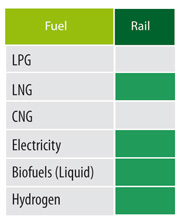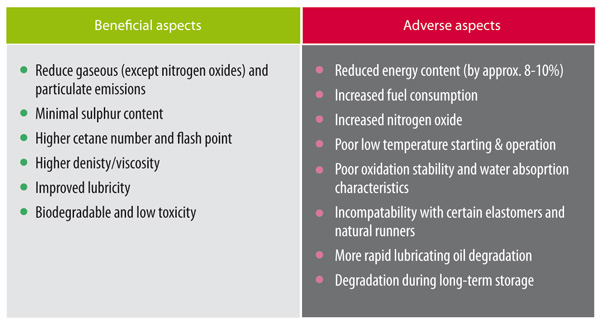Biofuels for rail transport
Overview
Current status:
Railway transport is very energy efficient. Final energy consumption for railway transport in the EU was 7.3 Mtoe in 2011, which represents 2 % of total energy consumption for transport. In passenger transport 6.3 % of km were done by rail (407.1 billion pkm), whereas 11 % of goods transport were done per rail (420 billion tkm). The railway network in EU (2010) was 212,800 km with 112,000 km of electrified rail lines. In 2011 the vehicles stock of locomotive and railcars amounted to 59,269 (EC 2013).

Alternative fuels for rail transport
In rail transport various alternative fuels could be used, such as liquefied natural gas, electricity, liquid biofuels and hydrogen (see figure 1). As the highly travelled parts of the railway network are electrified, the majority of alternative fuels in rail transport comes from renewable electricity. Only 20 % of EU railway operations comes from diesel traction (UIC 2007), and for this share biodiesel could be an alternative fuel. Other biofuels are of secondary importance, possible fuels would be BtL and HTU diesel, biogas and biomethane, bioethanol and biobutanol and biomass used for electricity generation in CHP systems.

Figure 1: Coverage of rail transportation by the main alternative fuels (COM (2013) 17)
The most promising option for biofuels in rail transportation sector is biodiesel. The global consumption of liquid fuel by the railways, which is mostly diesel, is likely to be up to 34,000 million litres (1.380 PJ). The EU only accounts for 15 % of the industrialised countries’ use of diesel on the railways, whereas the consumption is dominated by the US (70 %). In the US the consumption of liquid fuels by railways was growing (from 1990 to 2002), in the EU and in Canada liquid fuel consumption was decreasing (UIC 2007).
Biodiesel is technologically feasible for blending in diesel traction systems, but there is relatively little experience with using biodiesel in railways. Details of a few trials of biodiesel in rail transport globally are included below. There are potential advantages and disadvantages of using FAME in rail transport, which are given in figure 2.

Figure 2: Advantages and disadvantages of using biodiesel in rail transport (UIC 2007)
Most engine manufacturers appear to be willing to include B5, but they are less willing to include use of higher blends like B10, B15, B20 or even B100 (UIC 2007). Additionally tax incentives for biofuels are not so significant, since rail often pays relatively less duty on its fuel compared to road transport. Therefore it would be quite a challenge to enhance biodiesel use in rail transport.
Future perspectives in rail transport
Rail transport is one of the transportation modes which will be strengthened and increased in the future. The EU set ten goals for a competitive and resource efficient transport system for achieving the 60 % GHG emission reduction target. One of the goals is that 30 % of road freight over 300 km should shift to other modes such as rail or waterborne transport by 2030, and more than 50 % by 2050. Another goal concerning rail transport is that by 2050 a European high-speed rail network should be completed and the majority of medium-distance passenger transport should go by rail (COM (2011) 144).
Trials and use of biodiesel in rail transport globally
A number of European rail operators have carried out bench and field trials on rail vehicle and engines (e.g. French SNCF, German DB, Czech CD, Hungarian MAV).
In 2010/2011 Amtrak began a one-year trial of B20 in a diesel locomotive opreating in the southern states of the US. Montana State University carried out a similar trial on the BNSF railway in 2011. The trials could help establish a mandate for use of biodiesel blends in locomotives in the US.
In August 2012 Indian Railways announced plans for 4 biodiesel plants.
References and links of biofuels and rail transport
In 2007 the International Union of Railways UIC in association with the UK Association of Train Operating Companies ATOC published a short report Railways and Biofuel. The reports concluded: "Test results from railways in Europe and India reveal that biodiesel is technical feasible for use in railway traction units engines in lower blends. However, there are potential disadvantages of using higher blends, e.g. increased fuel consumption and lower engine power." UIC also organised the first ‘Railways and Biofuel Workshop’ in July 2007.
COM (2013) 17: Clean Power for Transport: A European alternative fuels strategy
EC 2013: EU transport in figures – statistical pocketbook 2013
